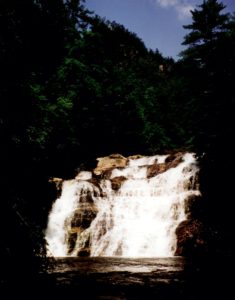(The following story ran in the Daily Item on June 21, 1998)
DAMASCUS, VA — I’m not sure what I was more excited about as I neared Damascus, Va. on my Appalachian Trail hike — the Virginia state line, Quincey’s Pizza or a laundromat.
The state border meant I had finally reached Virginia and put 450 of the trail’s toughest miles under my feet. Quincey’s Pizza, a Damascus landmark for hikers, meant I could make a dent in my appetite, which has been ravenous for most of the last month — with Quincey’s famous “hiker-sized” calzone.
But the laundromat meant I could finally wash and dry my clothes after a week that was, without question, the most trying stretch of the entire trip thus far.
As I plodded along, the sound of rain hit the summer canopy and the shrill wind conspired to make an almost mocking sound, as if laughing at my futility. “You can’t win,” it seemed to say.
“I will win!” I retorted angrily into the rain, realizing only later that I had said it aloud.
So all things considered, I think I’d pick the laundromat.
For most of the last seven days and 100 miles as I hiked through northeastern Tennessee, the Appalachian Trail served up near-record cold temperatures, driving rain, wind, fog and thunderstorms.
At 6,200-foot Roan Mountain in Tennessee, I awoke to a windy, damp morning with temperatures in the high 30s. With constantly wet and foggy conditions, everything from clothes to sleeping bags to boots get wet and dirty and had virtually no opportunity to dry.
Waking up each day to cold rain was extremely demoralizing, and hiking every day in those conditions was difficult, slow and frustrating.
In the heavy rain, the trail more often resembled a small stream, and especially on descents, every step was treacherous. I fell once, stumbled several times and grew irritated more times than I can count.
Where the trail climbed to a supposedly spectacular vista, all I saw was fog. Often, if I picked my head up to have a look around, I was greeted by a cold slap of wind and rain across my face.

Forecast for Tennessee: Fog and more fog.
As I plodded along, the sound of rain hit the summer canopy and the shrill wind conspired to make an almost mocking sound, as if laughing at my futility. “You can’t win,” it seemed to say.
“I will win!” I retorted angrily into the rain, realizing only later that I had said it aloud.
Hiking the entire Appalachian Trail from Georgia to Maine is, after all, a mental game, a battle of the will. After the last week, I understand why many veteran hikers say a thru-hike is 20 percent physical and 80 percent mental. In fact, word along the grapevine is many potential thru-hikers have already called it quits, their spirits broken by the unusually heavy rain.
The only way to succeed, I’ve learned, is to persist.
“Fight through the tough days,” I tell myself, “and better days will follow.
Sure enough, after four straight days of rain last week, the weather broke for a few hours. I was treated to sunny skies, a delightful breeze and 70-degree temperatures as I descended into the scenic Laurel Fork gorge.
It was as if the trail gods called off their offensive, acknowledging that I had passed my first test.
At Laurel Fork, the trail drops nearly 1,000 feet through a rhododendron gorge to Laurel Falls, a 50-foot, stream-fed waterfall that sits like a sunken treasure at the bottom of the gorge. For the next mile, the trail meanders along Laurel Fork, hugging sunlit streams and rushing rapids. To date, this is my favorite spot on the entire trail.

Laurel Fork Falls
The respite from the rain was brief, though. After I climbed out of the gorge, the rain resumed and continued for the next two days. Then, finally, in a thunderstorm I reached Damascus, a town of 1,200 tucked into the southwest corner of Virginia.
Tired and wet, I neverthless felt strengthened knowing I had weathered this first major mental test.
Now I turn my attention to the mid-Atlantic states, where the Appalachian mountains are a little more benign; the trail doesn’t climb above 6,000 feet again until New Hampshire.
Mount Rogers, the highest mountain in Virginia at 5,729 feet, looms in the next couple of days, followed by a long stretch of gently sloping hills and valleys through the Blue Ridge.
Before anything else, though, I’m off to the laundromat, and then to Quincey’s for that hiker-sized calzone.